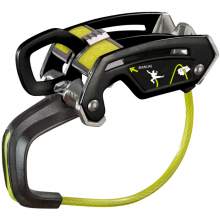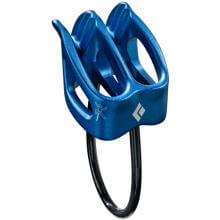Compare
Giga Jul |
ATC Alpine Guide |
ATC Guide |
ATC Pilot |
Jul² |
Mega Jul 2023 |
Micro Jul |
ATC XP |
ATC |
|
Edelrid |
Black Diamond |
Black Diamond |
Black Diamond |
Edelrid |
Edelrid |
Edelrid |
Black Diamond |
Black Diamond |
|
| Rating | |||||||||
| Retail Price (US$) | $59.95 | $34.95 | $34.95 | $49.95 | $45.95 | $49.95 | $49.95 | $24.95 | $21.95 |
Weight (g)  Weight (g)In grams, the weight, as stated by the manufacturer/brand. |
120 g
|
73 g
|
80 g
|
86 g
|
105 g
|
65 g
|
62 g
|
64 g
|
60 g
|
Device Type  Device TypeTubeThe most commonly used belay type also called an “ATC” or “tuber.” Other than a distinction between other belay device types, “Tube” is a rarely used term, most climbers just assume you're talking about this style when they refer to your "belay device." 
Figure 8Mostly used in rescue, canyoneering, tactical, work safety, or by old school climbers and rappellers. One reason they went out of popularity with recreational climbers is because they tend to create twists in the rope. 
Brake AssistThese devices assist in stopping the rope when a climber falls or hangs on the rope. 
Often referred to as “auto-blocking” but that’s not the official terminology because no belay device should be assumed to work automatically by itself, even if it feels like it does (or does most the time). PlateWhen simplicity is a must, or you started climbing before Tubers were the norm. Bonus: They tend to be very light weight. 
DescenderFor rappelling, not for belaying a lead climber or top-roping.  |
Brake Assist - Tube
|
Tube
|
Tube
|
Brake Assist - Tube
|
Brake Assist - Tube
|
Brake Assist - Tube
|
Brake Assist - Tube
|
Tube
|
Tube
|
Belay Brake Assist  Belay Brake AssistThis is when the belay device significantly reduces the amount of holding power the belayer must exert to stop a fall and hold a climber. This is also called "assisted-braking" as the device must hold a significant amount of the climber’s weight; this term does not include friction-adding "teeth" found on some tube style belay devices. Confusingly referred to as “auto-blocking” or “auto-locking” these terms wrongly imply the device will always, automatically, stop a fall or hold a climber even if the belayer/rappeller is hands-free. These devices are not meant to be used without a hand on the braking side of the rope; the belayers/rapppeller brake hand should always be on the brake rope. Worth ConsideringMost of the mechanical brake assist devices only hold a single strand of rope and are not capable of double-strand rappelling (the most common method of rappel). |
Yes
|
No
|
No
|
Yes
|
Yes
|
Yes
|
Yes
|
No
|
No
|
| Rope Options | 1 or 2 ropes
|
1 or 2 ropes
|
1 or 2 ropes
|
1 rope only
|
1 rope only
|
1 or 2 ropes
|
1 or 2 ropes
|
1 or 2 ropes
|
1 or 2 ropes
|
Guide Mode  Guide ModeThis is when you belay directly off the anchor instead of your harness. Guide mode is helpful if you climb outdoors a lot because it reduces the holding power required from the belayer. When your partner falls or rests, the weight of the climber is held mostly by the anchor and the belay device. Tubers and PlatesWhen belaying in "guide mode," the tubers and plates turn auto-blocking. During a fall, the climbing rope pinches the slack rope, completely stopping the movement of either rope. A common guide mode setup shown below. 
Mechanical Brake Assist DevicesThere is no difference in the functionality of the device. A brake-hand should always be on the rope to ensure the climber is caught in the case of a fall. A common guide mode setup shown below. 
Where guide mode is used
Learn Morehttp://www.climbing.com/skill/essential-skills-auto-blocking-belay-devices/ |
Up to 2 followers
|
Up to 2 followers
|
Up to 2 followers
|
No guide mode
|
No guide mode
|
Up to 2 followers
|
Up to 2 followers
|
No guide mode
|
No guide mode
|
Teeth  TeethTeeth are only seen on tube devices. They add friction that helps grip the rope for more belaying control. This is helpful for belaying heavier climbers. Teeth are becoming standard on new tube devices. 
Worth ConsideringTeeth do wear out. You can limit wear by rappelling on the side without teeth (if you don’t need the extra friction). Once they’re worn, you’ll still have a usable belay device, just less friction. |
No
|
Yes
|
Yes
|
No
|
No
|
No
|
No
|
Yes
|
No
|
Smallest Rope (mm)  Smallest Rope (mm)The smallest rope diameter, in millimeters, that the manufacturer/brand specifies can safely be used. This is the best case scenario and does not necessarily take into consideration that certified ropes have a tolerance of +/- .3 mm. |
7.1 mm
|
6.9 mm
|
8.1 mm
|
8.7 mm
|
8.9 mm
|
7.9 mm
|
6.9 mm
|
7.7 mm
|
7.7 mm
|
Largest Rope (mm)  Largest Rope (mm)The largest rope diameter, in millimeters, that the manufacturer/brand specifies can safely be used. This is the best case scenario and does not necessarily take into consideration that certified ropes have a tolerance of +/- .3 mm. |
10.0 mm
|
9.0 mm
|
11.0 mm
|
10.5 mm
|
11.0 mm
|
10.5 mm
|
8.9 mm
|
11.0 mm
|
11.0 mm
|
| Full Profile | View details | View details | View details | View details | View details | View details | View details | View details | View details |
| Where to buy | See best price | See best price | See best price | See best price | See best price | See best price | See best price | See best price | See best price |









